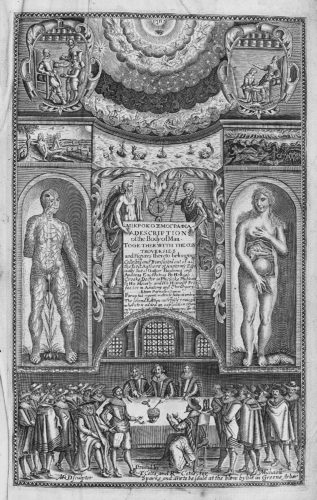Helkiah Crooke was court physician to James I, and his magisterial Mikrokosmographia: A Description of the Body of Man became the most important vernacular text on anatomy in seventeenth-century England. The title refers to the idea of the body as a microcosmos, or little world.
As a compendium of received knowledge about the body, adapted from a range of classical and contemporary sources, Crooke’s book nonetheless combined a heavy reliance on textual authorities with (in his words) ‘passages out of my owne observations’. Most radically, Crooke choose to write in English, rather than Latin, making his work accessible to a relatively broad audience; a move which enraged the College of Physicians, who objected to the wider dissemination of what they saw as their own specialist knowledge.
Also controversial were Crooke’s descriptions and illustrations of the female reproductive system, which were seen as scandalous, even pornographic. One example is included on the title-page of the 1631 edition (pictured). The image of the woman on the right hand side of the page also appears in book four of the work, where it is labelled as ‘the portraiture of a woman great with child whose wombe is bared’. Strangely, the woman modestly covers her breasts and genitalia even as her womb is exposed, in a gesture that oddly sexualises the dissected body even in attempting to conceal it.
Ultimately, efforts to suppress the book failed, and it proved very popular; Mikrokosmographia was reprinted five times in the decades following its initial publication. Interestingly, the printer of the first edition was William Jaggard, who is better known today as the publisher of Shakespeare’s First Folio. Crooke’s own writing suggests that its author was deeply familiar with contemporary poetry as well as medicine; at points, his language echoes the verse of Edmund Spenser and Guillaume Du Bartas.











